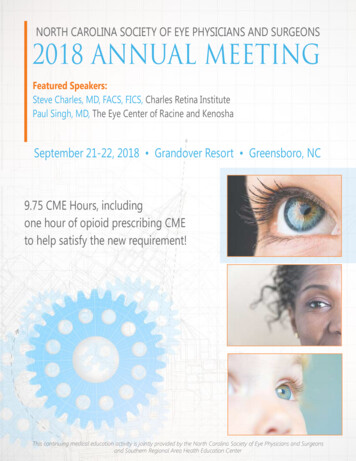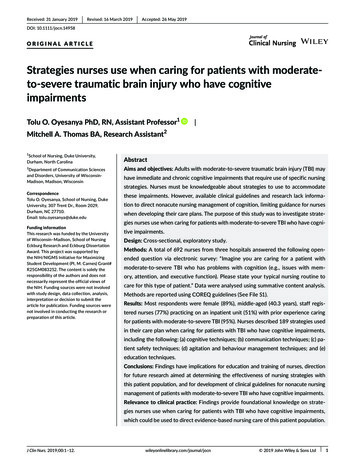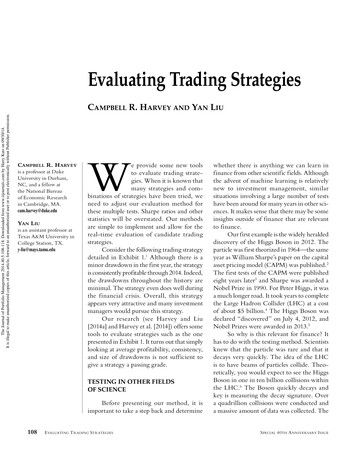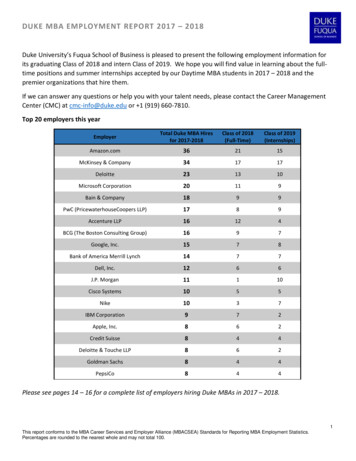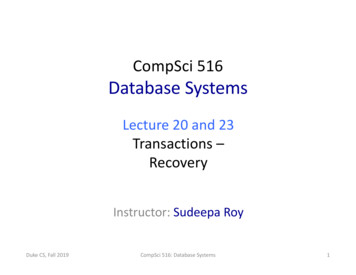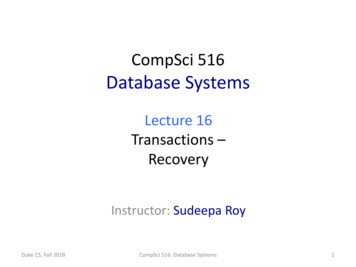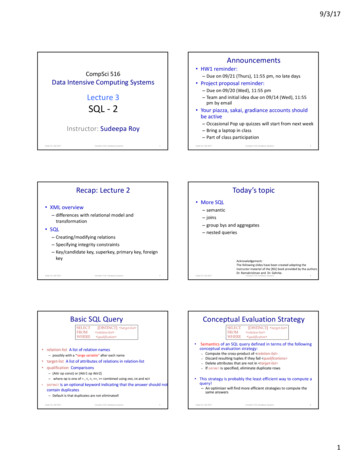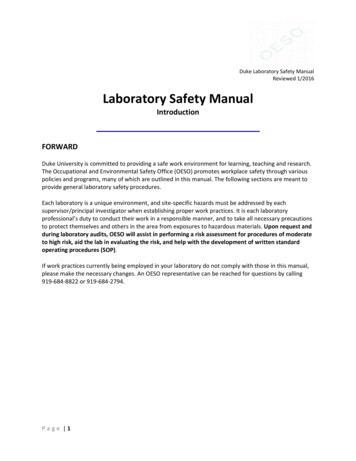
Transcription
Duke Laboratory Safety ManualReviewed 1/2016Laboratory Safety ManualIntroductionFORWARDDuke University is committed to providing a safe work environment for learning, teaching and research.The Occupational and Environmental Safety Office (OESO) promotes workplace safety through variouspolicies and programs, many of which are outlined in this manual. The following sections are meant toprovide general laboratory safety procedures.Each laboratory is a unique environment, and site-specific hazards must be addressed by eachsupervisor/principal investigator when establishing proper work practices. It is each laboratoryprofessional’s duty to conduct their work in a responsible manner, and to take all necessary precautionsto protect themselves and others in the area from exposures to hazardous materials. Upon request andduring laboratory audits, OESO will assist in performing a risk assessment for procedures of moderateto high risk, aid the lab in evaluating the risk, and help with the development of written standardoperating procedures (SOP).If work practices currently being employed in your laboratory do not comply with those in this manual,please make the necessary changes. An OESO representative can be reached for questions by calling919-684-8822 or 919-684-2794.Page 1
Important NumbersEmergency Numbers Medical Emergency: 911 Duke University Police: 911 from acampus phone; 919-684-2444from a cell phone Chemical Spill: 911 from a campusphone; 919-684-2444 from a cellphone Radioactive Materials Spill: 911from a campus phone; 919-6842444 from a cell phone Occupational Exposure: 115 (oncampus), 919-684-8115 (offcampus or from cell phone) To report workplace safetyconcerns/ unsafe workingconditions: 919-684-2794Safety Occupational & EnvironmentalSafety (administration):919-684-2794 Contractor/Work-Site Safety:919-684-5996 Biological/Laboratory Safety:919-684-8822 Fire Safety: 919-684-5609 Radiation Safety: 919-684-2194 Ergonomics: 919-668-(ERGO)3746Page 2Regulated Laboratory Waste General Questions: 919-684-8822 Environmental “Room” Services'Biomedical Waste Division (MedicalCenter Sharps Boxes/Red Bags):919-681-2727 Chemical Waste: 919-684-2794 Radioactive Waste: 919-684-2794 Animal Carcasses: 919-684-5212Occupational Hygiene & Safety(919-684-5996) General Questions Asbestos Abatement Noise/Air Monitoring Reproductive Health Risks at Work Respiratory ProtectionOther Employee Occupational Health andWellness (EOHW) 919-684-3136 Environmental Services UniformRoom (Lab Coat Laundering): 919684-3784 Division of Laboratory AnimalResources: 919-684-2797 Grants & Contracts: 919-684-3030 University Maintenance:919-684-2122 Medical Center (buildings)Maintenance: 919-684-3232
Section 1 General SafetyChapter 1IntroductionLaboratory Safety ManualSection 1General SafetyINTRODUCTIONPURPOSEThis section has been prepared to provide Duke University laboratory personnel with information aboutgeneral requirements related to safety and prevention of injuries in laboratories. Laboratory personnelare reminded that the policies in the University Safety Manual apply in the lab environment.HAZARDS ADDRESSEDThis section primarily addresses equipment and hazards that may cause physical injury such as cuts,burns, slips/trips/falls, traumatic injury, or electrical shock. Subsequent chapters address exposure tohazardous biological materials and chemicals. Radioactive materials and lasers are covered in theRadiation Safety Manual and the Laser Safety Policy.DEFINITIONSHigh Risk Procedures – Lab procedures which pose significant risk of serious injury or major propertydamage if an unexpected event were to occur (such as a utility outage or equipment failure/misuse)and/or which May expose research personnel to hazardous energy (e.g., electricity or high pressures). Require specialized training not covered by another Duke Safety policy. Require specialized personal protective equipment in addition to gloves, lab coats, eye/faceprotection and/or thermal protective aprons or sleeves (for example, fall protection).Laboratory - A facility for scientific experiments, research, or teaching where equipment and/ormaterials are designed to be easily and safely manipulated by one person. Laboratory work mayinvolve relatively small quantities of hazardous materials used on a non-production basis, orexperimental equipment generating hazardous energy (such as pressure, microwaves, or heat)on a small scale. The equipment and/or materials used in a laboratory are not part of aproduction process, nor in any way simulate a production process. In a laboratory, “protectivelaboratory practices and equipment” are available and in common use to minimize the potentialfor employee exposure to hazardous materials or energy.Protective laboratory practices and equipment – Those laboratory procedures, practices andequipment accepted by laboratory health and safety experts as effective, or that the employercan show to be effective, in minimizing the potential for employee exposure to hazardousmaterials or hazardous energy.Page 1
Section 1 General SafetyChapter 2ResponsibilitiesRESPONSIBILITIESIt is the responsibility of the Principal Investigator to ensure the safety of persons working orvolunteering in his/her laboratories.Department Heads shall: Ensure compliance with all safety requirements within their departments. Establish criteria and processes for Departmental review of hazard assessments/lab-specificStandard Operating Procedures for High Risk Procedures.Principal Investigators (Research Labs)/Directors (Clinical Labs) shall: Ensure compliance with all safety requirements within the laboratory or laboratories.Provide direction and support to the Laboratory Safety Coordinator, if one is designated, orundertake the responsibilities of the Laboratory Safety Coordinator if no one is designated forthat role.Perform a hazard assessment and develop/approve lab-specific Standard Operating Proceduresfor all high-risk procedures.When it is required by the department, submit High Risk Procedure hazard assessments fordepartmental review and maintain documentation that this review was completed.Before allowing minors or non-Duke employees to volunteer or work in the laboratory, submitand receive approval using the “Workplace Safety Statement for Minors and Non-Employees atDuke”. The PI must ensure compliance with the policy on Minors/Non-Employees in WorkAreas.Laboratory Safety Coordinators shall: Work with the Principal Investigator to develop and document necessary laboratory-specificstandard operating procedures. Read and be familiar with this section of the Laboratory Safety Manual. Train laboratory employees and students when there is new laboratory-specific safetyinformation or when a new employee or student is assigned to the laboratory. Documenttraining as described under Laboratory-specific Training. Training must be documented for allpaid employees (graduate students, post-docs, paid work study, or other wage or salariedpersonnel) in the laboratory; it is recommended that training be documented for non-paidstudents as well. Examples of topics to be included in the training are detailed under Laboratoryspecific Training. Coordinate interaction with the Occupational and Environmental Safety Office, EmployeeOccupational Health and Wellness, and other Duke departments or outside agencies as neededfor laboratory audits, incident/accident investigation, medical care, and emergency response. Post the Emergency Response and Incident Reporting Guide (available from OESO – 919-6842794) in the lab near the door or main laboratory telephone.Laboratory Employees and Students shall: Plan and conduct laboratory operations in accordance with federal regulation and applicableUniversity safety policies (in this manual, the University Safety Manual, the Radiation SafetyManual, and the Laser Safety Policy).Abide by all policies and procedures described in any department or laboratory-specific policies.Page 2
Section 1 General SafetyChapter 2Responsibilities Report all injuries, other incidents, and unsafe conditions to their supervisor and PI, and to theappropriate university support groups as described in the Laboratory Emergency Response andIncident Reporting Guide.The Occupational and Environmental Safety Office (OESO) shall: Develop and provide general laboratory safety training.Conduct periodic safety audits of laboratories.Investigate laboratory accidents and injuries.Review and provide input on safety measures for High Risk Procedures when requested by thePI or Department.Employee Occupational Health and Wellness shall: Provide medical care for employees who have been injured.Page 3
Section 1 General SafetyChapter 3General Hazard Information and TrainingGENERAL HAZARD INFORMATION AND TRAININGRequired Hazard Awareness TrainingGeneral Lab Safety Training:Each laboratory employee (including P.I.s) and student shall be required to take a general laboratorysafety course online before beginning work in the lab and annually thereafter.Other General Training:Laboratory employees or students exposed to general hazards that are not covered in the generallaboratory safety training may be required to take other applicable safety trainings offered by theOccupational and Environmental Safety Office. Examples include: Vehicle Safety Policy training and Defensive Driver training for laboratory personnel whooperate Duke Vehicles. Lockout-Tagout training for laboratory personnel who may perform service or maintenance onequipment where the unexpected start-up, energization, or release of stored energy could occurand cause injury. (See the Hazardous Energy Control Policy for more information.) Hearing Protection or Hearing Conservation training for employees exposed to hazardous noise.(See OESO Online Training Page for links to these courses.) Ladder Safety training where step ladders or extension ladders are used. (See OESO OnlineTraining Page for a link to this course.)Laboratory-specific Training:The Principal Investigator or Laboratory Safety Coordinator shall conduct laboratory-specific hazardawareness training for each laboratory employee or student before that person begins working in thelab. This hazard awareness training shall be reviewed as necessary and any time a new hazard isintroduced. Records shall be kept to indicate topics covered, name of person providing training, personsin attendance, and the date.Examples of information to be covered (when applicable) in laboratory-specific training are listed below: The location and contents of the Laboratory Emergency Response and Incident Reporting Guide. Departmental or lab-specific incident reporting requirements. Location of emergency equipment such as fire extinguishers and fire alarm pull stations. Location of the lab’s emergency assembly point (EAP). (See the site-specific fire plans online forEAPs for campus buildings.) Proper use and disposal of razor blades or other sharps (including broken glass disposal boxes). Safe use and storage of stepladders or stools. Equipment or areas requiring hearing protection. Safe use of laboratory equipment.oPage 4For any laboratory equipment, refer to the equipment manual for safety instructions.
Section 1 General SafetyChapter 3General Hazard Information and TrainingoFor electrical equipment, including extension cords, see the Electrical Safety Policy.oFor machine tools, see the Academic Shop Policy. Safety procedures for Fieldwork. Appropriate methods for disposing of various types of waste generated in the lab. Laboratory standard operating procedures for any High Risk Procedures.Required Sources of General Hazard InformationEquipment Hazard Labels:When there are hazard labels on purchased equipment (such as labels indicating possible electricalshock, sharp edges, or pinch points), laboratories shall not remove or deface these labels.If laboratories produce or assemble equipment that could cause injury, warning labels arerecommended.Equipment Manuals:If laboratory equipment is provided with a manual that includes safety warnings, the manual (or at leastthe safety warnings) must be accessible to laboratory personnel. Laboratories are encouraged tomaintain a list of equipment manuals that contain safety information and to require staff to signindicating that they have read the applicable safety information for the equipment they will use.Page 5
Section 1 General SafetyChapter 4General Safety Procedures for the LaboratoryGENERAL SAFETY PROCEDURES FOR THE LABORATORYIntroductionThis section covers common safety concerns noted in laboratories. Where applicable, policies in theUniversity Safety Manual are referenced for detailed requirements.Consideration of Safety during ProcurementWhen purchasing laboratory equipment, consider the safety of laboratory personnel. Considerationsinclude: Presence of engineered safeguards – When possible, choose equipment that isolates users fromheat, sharp edges, pinch points, hazardous energy (such as ultraviolet light, microwaves, orother energy sources), and hazardous materials. If laboratory personnel will maintainequipment, consider their safety during maintenance activities as well as normal operations. Noise – When possible, choose equipment that generates less noise. If equipment producesnoise levels over 85 dBA, see the Occupational Noise Exposure Policy for requirements. Ergonomics – When possible, choose equipment that:o Allows users to maintain neutral postures,o Adjusts for multiple users,o Minimizes repetitive activities, ando Runs automatically instead of requiring manual operation.Safe Work PracticesGeneral Housekeeping, Storage and Use of Equipment, and MaintenanceKeeping the laboratory clean, organized, and functioning properly can help to prevent incidents andinjuries. General housekeeping, storage, and maintenance practices are described below. Never obstruct access to exits and emergency equipment such as eyewashes, drench hoses, andsafety showers.Keep the work area clean and uncluttered, with equipment and hazardous materials properlystored. Secure or position benchtop equipment so that it will not be knocked over. Keep drawers and cabinets closed and cords and cables off the floor to avoid tripping hazards.Use cable management devices to bundle cords and cables together under desks and labbenches. Keep items off the floor to allow your housekeeping service to clean effectively, and to reducethe risk of trips and falls.Keep aisles clear of stored materials. Arrange workspace efficiently to allow personnel to maintain neutral postures, minimizerepetitive activities, and minimize forces required while working. Promptly clean up spills and dropped materials/equipment to avoid slip hazards. (For chemicalspills, see the Chemical Safety Chapter).Page 6
Section 1 General SafetyChapter 4General Safety Procedures for the Laboratory Keep sink traps and floor drain traps filled with water at all times to prevent the escape of sewergas into the laboratory. Alternately, contact your maintenance provider to fill infrequently-usedtraps with linseed or other oil that is safe for sewer disposal (since the oil will evaporate lessrapidly than water). Keep sharp or pointed tools properly sheathed or otherwise stored safely when not in use. Hang clothing in proper locations; it should not be draped over equipment or benches. Do not store excess cardboard boxes, equipment boxes, Styrofoam, or lab equipment under labbenches or above shelves/cabinets throughout the lab. This can be a safety as well as a firehazard. Promptly notify the laboratory safety coordinator or PI and contact your maintenance orequipment service provider when lighting, vacuum lines, or other laboratory equipment is notfunctioning properly. Until the repair is completed, tag the affected equipment as “out ofservice”. Advise maintenance/service personnel of hazards they may encounter during repair.Working alone –Prior approval of the Principal Investigator is required for working alone after hours.Generally, it is prudent to avoid working alone in a laboratory. Individuals working alone should makearrangements with other lab personnel to check on them periodically, or ask security guards to check onthem. High Risk Procedures must not be performed by personnel working alone.Unattended experiments –High Risk Procedures should not be left unattended, but if circumstances require that the experimentrun when the lab is not occupied, seek the approval of the Principal Investigator or laboratory safetycoordinator in advance.Water taps should not be left open and unattended because of the potential for flooding. This includesrunning tap water for cooling, or filling tanks or other containers with water.Safe use and disposal of sharps –Handle and store laboratory glassware with care to avoid damage; do not use damaged glassware.Dispose of broken glassware using broken glass disposal boxes.Choose safe cutting devices – use of straight razors should be avoided in favor of safety scalpels or otheralternatives. Straight razors should not be used when a safer cutting device (e.g., scissors, box cutter) ismore appropriate.Uncontaminated razor blades and needles must be disposed of in puncture-resistant hard-sided sharpsdisposal boxes. If red sharps boxes are used, mark out any biohazard warnings and write “not abiohazard” on the box. For safe disposal of contaminated sharps, see the Biological Safety or ChemicalSafety Sections, or the Radiation Safety Manual, as appropriate.Safe use of laboratory equipment –In general: Use equipment only for its designated purpose.Be familiar with the manufacturer’s instructions before using.Page 7
Section 1 General SafetyChapter 4General Safety Procedures for the Laboratory Inspect equipment for damage; do not use damaged equipment.Use of laboratory equipment requiring highly specialized training shall be considered a high riskprocedure if accidental misuse of the equipment could cause injury or damage to the building. Labspecific standard operating procedures, including training for operators, must be developed andapproved by the PI.Electrical safety –Included below are requirements from the Electrical Safety Policy that are commonly applicable tolaboratories. See the Electrical Safety Policy for further details and additional requirements. Extension cordsoExtension cords shall not be used as substitutes for permanent wiring. Extension cordsmay remain in place for no more than 30 days if they are in continuous use andotherwise comply with requirements for extension cords. Contact the appropriatemaintenance department to install permanent wiring where needed.oExtension cords shall not be plugged into one another so as to increase the overallreach.oAll extension cords purchased or in use shall be the three wire type and have aminimum wire size of 14 AWG.Power stripsoPower strips may be used to supply office equipment.oPower strips shall not be plugged into one another so as to increase the overall reach ornumber of available outlets.oAll power strips purchased or in use shall have a cord 6 feet or less in length, a 15 ampcircuit breaker/fuse, and a surge protector. Extension cords and equipment cords shall not be run through doorways or in any other mannerthat may result in damage to the cord unless cord protectors are in place. The purchase or use of cube taps to expand the capacity of an outlet is prohibited.Some laboratories may have other electrical hazards present and may therefore require additionalelectrical safety precautions. Specifically: Use of high voltage power supplies shall be considered high risk procedures requiring PIapproval.Page 8oWritten lab-specific safety procedures, approved by the PI, shall be developed. Thesemay reference the manufacturer’s instruction manual, but must include specificinstructions for the experiment being conducted.oAny personnel working with high voltage power supplies shall be trained on the hazardsand shall be familiar with manufacturer-supplied safety information and lab-specificprocedures.oWarning signs shall be in place when high voltage power supplies are in use.
Section 1 General SafetyChapter 4General Safety Procedures for the Laboratory Where laboratory personnel maintain or service hard-wired electrically-powered laboratoryequipment, the Hazardous Energy Control Policy applies. For more information and to arrangerequired training, see the OESO webpage on Lockout/Tagout and contact OESO – OccupationalHygiene and Safety at 919-684-5996. Labs are reminded that the Electrical Safety Policy requires that electrical installations,modifications, and repairs are to be made only by Duke-employed electricians and other tradesperforming electrical work within the scope of their trade, or authorized contractors. If the lab will create or modify electrically-powered equipment, see paragraph below on“Controlling exposure to hazardous energy”.Safety during field research–Refer to the Fieldwork Safety Policy and Fieldwork Safety Plan Template for requirements and guidelinesrelated to fieldwork. The Safety Guidelines for Fieldwork provides reference information that may beuseful for researchers conducting field research.Safe use of machine tools and portable power tools –Refer to the Academic Shop Policy for requirements and guidelines related to use of machine tools andportable power tools in the laboratory environment.Safe use of vehicles–Refer to the Vehicle Safety Policy for requirements and guidelines related to driving Duke-owned orleased vehicles and for the Corporate Risk policy on use of personal vehicles for Duke business.Controlling exposure to hazardous energy –Where laboratory personnel maintain laboratory equipment connected to compressed air, steam,electricity or other hazardous energy sources, the Hazardous Energy Control Policy may apply. For moreinformation and to arrange required training, see the OESO webpage on Lockout/Tagout and contactOESO – Occupational Hygiene and Safety at 919-684-5996.Procedures that could expose personnel to hazardous energy (in the case of equipment failure ormisuse) will be considered high risk procedures requiring a hazard assessment and/or written standardoperating procedure. The hazard assessment/written SOP will require the approval of the PI and, inmany cases, the department.Where labs create or modify equipment that uses hazardous energy (including electricity, compressedair, steam, vacuum, etc.), the creation or modification of the equipment and its initial testing will beconsidered a High Risk Procedure requiring the review of the PI. The lab planning to create or modifysuch equipment will seek guidance from the department to determine if departmental review andapproval will be necessary. A hazard assessment shall be performed, and the review and approvalthereof shall be documented in writing and kept with the hazard assessment.Personal Protective Equipment (PPE)This section covers personal protective equipment for general physical hazards commonly present inlaboratories. For PPE requirements and recommendations for hazardous materials and lasers, see theBiological Safety or Chemical Safety Sections of this Manual, or the Radiation or Laser Safety Manuals, asappropriate.Page 9
Section 1 General SafetyChapter 4General Safety Procedures for the LaboratoryLaboratory procedures that require specialized personal protective equipment, such as personal fallarrest systems or arc-flash clothing, are considered high-risk procedures. A hazard assessment, writtenlaboratory-specific procedures, and PI approval are required. In some cases, Departmental approval mayalso be required. OESO may be consulted for advice on specialized PPE and/or review of procedures.Gloves – Thermal gloves should be worn for contact with hot surfaces such as (dry) equipment beingremoved from ovens or autoclaves, or the inside of a hot oven or autoclave. Heat-resistant impermeable gloves must be worn for handling hot liquids. Standard autoclavegloves are not appropriate. Cryo-gloves must be worn when retrieving materials from cryogenic freezers. Leather or cloth work gloves should be worn to protect the hands from scrapes, scratches, orsplinters during materials-handling activities. Cut-or puncture-resistant gloves should be worn when working with sharps. If these glovesreduce dexterity, consider wearing a cut-or puncture-resistant glove only on the non-dominanthand. If working with chemicals or infectious materials and sharps, wear the cut- or punctureresistant glove under the disposable glove. If the outer glove is damaged, remove both pairs ofgloves and wash hands thoroughly before continuing. Gloves should be worn when working around UV light sources to prevent skin exposure.Eye/face Protection –Safety goggles should be worn when working with glassware under reduced or elevated pressures andwhen handling glassware or liquids at high temperatures. If the risk of splash is high, a face shield shouldalso be worn. Safety glasses should be when there is a risk of eye injury from projectiles.Skin protection –If work in the laboratory may expose the skin to cuts, scratches, or burns, laboratory workers shouldminimize exposed skin through their choice of personal clothing and/or use of a lab coat.If there is a risk of splash with hot water, wear a standard lab coat, rubberized apron and heat-resistantimpermeable gloves.Foot protection –Closed-toed shoes should be considered standard attire for laboratory work, especially if there is a riskof dropping hot liquids or laboratory materials, or if materials-handling carts are used.Hazard Assessment & Documentation of Approval for High-Risk Procedures:When planning research involving High Risk Procedures (see definitions), the PI (or designee) mustperform a hazard assessment and/or develop a laboratory-specific Standard Operating Procedure, whichmust be approved by the PI, and in some cases by the Department, before beginning work.Documentation of approval must be kept with the hazard assessment/lab-specific SOP. For ChemicalHigh Risk Procedures, see the Chemical Safety Chapter.P a g e 10
Section 1 General SafetyChapter 5Preparing for and Responding to EmergenciesPREPARING FOR AND RESPONDING TO EMERGENCIESPreparednessTypes of incidentsEach lab should consider the types of incidents that could have an adverse effect on people, researchefforts, property, and/or the environment and engage in planning efforts aimed at mitigating the impactof the emergency (for example, arranging for critical laboratory equipment to be maintained onemergency power) and on the necessary response for each situation.Response actionsFor possible incidents, the lab should consider and prepare for the response actions that will be needed.Evacuation of the lab may be necessary in some emergency situations. Therefore, lab personnel need tobe familiar with how to get out of the building in the event of an emergency, and the location of thelab’s designated Emergency Assembly Point. Emergency Assembly Points in “The Site-Specific FirePlans” for campus buildings can be found on Fire Safety’s website e-safety.Written planWhere a response will be needed at the time of an emergency, a written plan should be prepared by thelab, describing the actions that will need to be taken.Resources and EquipmentEach lab should make sure that it has the equipment and other resources available to implement itsemergency plans. The following resources will be necessary for all research and clinical labs; ifadditional resources are needed, the Laboratory Safety Coordinator and PI should identify thoseresources in the written emergency plan, and make sure that they are available.Emergency Response & Incident Reporting Guide –Each lab should post an up-to-date copy of the Duke Laboratory Emergency Response and EmergencyReporting Guide near the exit and/or primary telephone for the lab. This guide lists emergency contactsand procedures for various types of incidents.Emergency Contact Information –Each laboratory unit or department should keep emergency contact information for laboratorypersonnel, especially the Principal Investigator and Laboratory Safety Coordinator. The purpose of thisinformation is twofold: In the event of a fire, flood, or other emergency affecting the lab, to allow emergency responsepersonnel to reach someone in the lab; and In the event of a lab-related or other incident requiring a member of the lab to seek medicalattention, to allow the Lab Safety Coordinator, PI, or department representative to reach afamily member or friend of the affected personnel.To facilitate contact with the lab in case of emergency (such as fire or flooding in the lab), labs shouldalso post contact information (including after-hours phone numbers) for key laboratory personnel on ornear the door to the lab. OESO has a laboratory door sign template that may be used.P a g e 11
Section 1 General SafetyChapter 5Preparing for and Responding to EmergenciesFire extinguishers –See the Fire Safety Section of the Laboratory Safety Manual for information on the types of fires andappropriate fire extinguishers.Emergency ResponseMost of the following information is also found in the Duke Laboratory Emergency Response andIncident Reporting Guide, which should be posted near the main exit and/or mail telephone for eachlab. Contact OESO Laboratory Safety at 919-684-8822 if you need a copy of this Guide.Personal Injury All work-related injuries and illnesses (including chemical spills onto the body), regardless of theseverity, must be reported to the supervisor. If needed, obtain medical care from the nearest Employee Occupational Health and Wellnesslocation (call 919-684-3136 for more information (after hours, call 919-684-8115)), or throughone of the other providers listed athttp://www.hr.duke.edu/bene
for laboratory audits , incident/accident investigation, medical care, and emergency response. Post the Emergency Response and Incident Reporting Guide (available from OESO - 919-684-2794) in the lab near the door or main laboratory telephone. . Safe use of laboratory equipment. o For any laboratory equipment, refer to the equipment .

